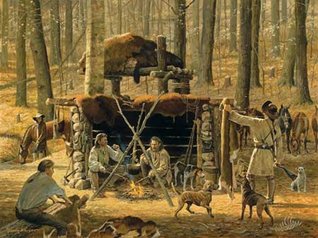
They want to know about the famous mountain men of Montana and the American west.
Also, they’re just interested in amazing and heroic stories, often involving man vs. nature or man vs. man.
These are great stories, and we’ve profiled many before.
- I wrote 10 Great Mountain Man Fur Trapping Books in 2013.
- I followed it up with 10 More Great Mountain Main Fur Trapping Books in 2015.
Now it’s time for a new post.
I hope these books interest you and that you learn more about this unique and interesting segment in American history.
Enjoy!
Jim Bridger: Mountain Man
|
|
Stanley Vestal wrote this book in 1970 and it’s a good one. It has 333 pages and 58 reviews on Amazon.
The book also has a rank of #23,000 or so, meaning it’s selling quite well. |
The early stuff is going to start up when William Henry Ashley got his hundred trappers together in 1823. The later stuff is when Bridger struck out on his own with the Rocky Mountain Fur Company in the 1830s, and then on his own further with Fort Bridger in the 1840s.
This is a mountain man that lived a long time. He didn’t die until 1881 and by then the fur trade was over. He spent his later years working as a guide, mostly for miners coming up into Montana from the southern Oregon Trail routes, and later the railroad routes that hadn’t quite made it as far north as the Montana Territory.
If you’re interested in famous mountain men, you’ll get a lot of ‘em in this book. The main focus is Bridger, however, and I think you’ll be impressed.
Jedediah Smith: No Ordinary Mountain Man
|
|
This 304-page book is another in the University of Oklahoma’s Western Biography series.
It was written by Barton Barbour in 2009 and takes another look at this famous mountain man. |
Despite that, new books will be written, old characters will be looked upon through a new lens of a new time.
Jedediah Smith’s time exploring Montana with the William Henry Ashley expedition is profiled, as well as his treks to California. You get the whole story, there’s not a lot new, just a new look at it. For die-hard history buffs of this era, it’s worth a look.
John Colter: Explorer, Mountain Man, and Trapper
|
|
This 1899 book by Charles Griffin Coutant is so short that it’s probably not worth your time.
I mean, the book is 6 pages! Thank God it’s priced at $0.99, right? |
Most reviews say the book is good but most also say how short it is. If you have to know everything about this famous mountain man, this one should also be in your collection.
Hugh Glass
|
|
This simply-titled book was written by Bruce Bradley in 1995.
It’s 354 pages and has 83 reviews on Amazon, a rank of #21,000 as well. |
So the book is popular and selling well. I personally think that’s because of the film The Revenant…which you can read more about in my post Is the Film The Revenant Historically Accurate?
This book tells the entire story of Glass’s life, but like one reviewer mentions, the author fills in the holes with what he think happened. Some call this fiction and aren’t happy. Most are pleased with the book, however.
Lots of people mention reading this biography of Hugh Glass because they saw the movie. That’s cool – Hollywood encouraging people to read. It doesn’t happen often!
I think this book is good for those interested in the fur trapping days of the 1820s and into the 1830s. I call that the second phase of American fur trapping, though if you wanted to get specific and factor in the British and French, it might be the third overall.
Either way, you’ll learn a lot about this famous mountain man and that’ll be fun for when The Revenant comes up in conversation.
Bill Sublette: Mountain Man
|
|
One book that doesn’t get much attention was written by John Sunder in 1973.
It’s about Bill Sublette, a mountain man that lived from 1799 to 1845. |
Late on into the 1830s it’d be Sublette who’d prove instrumental in getting that first wagon train of goods to the first mountain man rendezvous, making that revolutionary system possible.
Sublette also established the fort that would become Fort Laramie. He helped lay out Kansas City. And if that wasn’t enough, he broke the monopoly that John Jacob Astor had put upon the fur trade starting in the 1810s.
The book is 279 pages and has 8 reviews on Amazon, a rank of #438,000. So not many are buying this book, and I think that’s a shame.
The reviews are great, telling us about the book. All are 4- or 5-star. I hope you give this book a look, either on Amazon or at your local library.
Crow Killer: The Saga of Liver-Eating Johnson
|
|
This book originally came out in 1958 and serves as a biography of John Johnston, a man that lived from about 1824 to 1900.
Raymond W. Thorp wrote the book and it’s 208 pages long, has 174 reviews on Amazon, and is probably a great story for you. |
This particular man is thought to have fought a “one-man war on the Crow Nation with his Hawken rifle and Bowie knife,” the book’s Introduction tells us, “routinely cutting out and eating the livers of his foes, in revenge for the murder of his bride and unborn child.”
That’s pretty intense.
The truth is a little different. For instance, Chief Joseph Medicine Crow tells us that Johnston was actually friendly with the Crow and joined them in eating raw deer livers.
We know that Johnston was in one of the Wild West Shows put on in 1884 and that’s where he supposedly reenacted his liver eating, something the press picked up on. A legend was born.
I’ve not read this book and I don’t know much about this man. For the most part…I’m just not that far yet.
If you’ve read my mountain man/fur trapping work you know I’ve confined myself to the early-1800s, the 1810s, and a bit into the 1820s…that’s about it.
Johnston is a bit late for me…but I’ll get to him eventually. You don’t have to wait. I encourage you to look at this book on Amazon. The introduction alone will pull you in for a good 10 minutes or longer.
Trappers of the Far West: Sixteen Biographical Sketches
|
|
This book was written by LeRoy Hafen in 1983 and has 334 pages.
It has just 4 reviews on Amazon and a rank of about #420,000. Mainly, the book doesn’t sell that well. |
- James Beckwourth;
- Milton Sublette;
- Etienne Provost;
- Lucien Fontenelle;
- David Jackson.
There are plenty more, and in case you didn’t notice, they’re obscure figures…for the most part.
Hey, these aren’t the Glass’s and Bridger’s and Colter’s that we think of. No, these were the men doing the grunt work and not gettin’ much of the glory.
Check out their stories. Without ‘em, America might not have become the nation that she did.
The American Fur Trade of the Far West, Vol. 1
|
|
Hiram M. Chittenden wrote this book in 1902 and it remains one of the best works on the fur trade and the mountain man that made it what it was.
The book is 570 pages and has 5 customer reviews on Amazon. |
This one focuses on the early trade, then gets into Manuel Lisa’s St. Louis Missouri Fur Company, which was responsible for the first Fort Henry as well as Fort Raymond before it.
You get a very detailed look at the Astoria Expedition of Wilson Price Hunt in 1811, as well as the voyage of the Tonquin and its sad fate. After that there are some things about the 1820s with major names.
I have to admit, I get some of the chapters confused with the second volume. That second book is also great and we’ll profile it in another post.
Until then, I highly suggest you give this book a look at your local library. Paying $24.95, to me at least, is just a bit too much.
The Awakening Of The Desert: An Adventure-Filled Memoir Of The Old West
|
|
Julius Birge wrote this book in 1912 about an 1866 wagon trip on the Oregon Trail.
The book is 314 pages and has 22 reviews on Amazon. It goes for just $0.99 as an eBook. That accounts for its higher-than-usual ranking of #72,000. |
A lot of the reviews mention some boring parts about the Mormons and their history. Aside from that, it might interest you…especially at that price.
Indian History and Indian Wars of Montana
|
|
Micahel Leeson wrote this book in 1885 and Warner, Beers & Company published it.
I’ve never read it but right away I can see it has some good info. |
There were:
- 7,500 Blackfeet;
- 4,043 Yankton Sioux;
- 2,150 Flathead;
- 1,607 Pend O'reille and Kootenai;
- 1,409 Assiniboine;
- 1,135 Gros Ventre;
- 997 Assiniboine of the Missouri;
- 900 River Crow.
That comes out to about 20,000 Indians in Montana in 1884.
This book wasn’t published in eBook format until 2014 and it has no reviews on Amazon, a dismal rank of #898,000+.
This book is not selling and that’s a shame. Perhaps that’s because it’s only 94 pages, but at $1.99 that might not be a bad deal.
After all, look at those Indian numbers. I know this book has more great info. If this is your area of interest you’ll want to check it out.
Conclusion
Fur trapping had its heyday in America in the early 1800s and faded out by the 1840s. By the 1860s it was all but dead.
The Upper Missouri fur trade interests me the most, but these books we profiled also touch upon California, Oregon, and into Canada.
I hope you’ll earn a greater appreciation of American history by reading the books.
Thanks!

